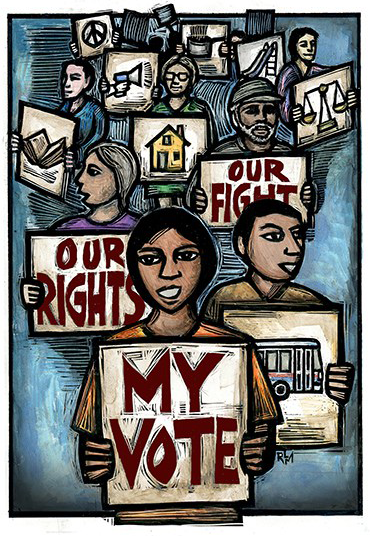By the Editors of Rethinking Schools
As teachers and students return to classrooms this fall, together we have to try to make sense of a tumultuous presidential campaign and a summer of racial violence that have forcefully surfaced the racism that plagues our nation.

“My Vote” by Ricardo Levins Morales.
Elementary and middle school students have grown up with an African American as president of the United States. This is a historic milestone. But these same students have also grown up in a nation that’s increasingly unequal, a country where police killed more Black people in 2015 than were lynched during the worst year of Jim Crow.
In the past several months, students have watched Donald Trump use racist, Islamophobic, misogynist, and anti-immigrant vitriol to whip up a terrifying level of support, with ominous repercussions no matter who wins the election.
Even as Black Lives Matter has spearheaded a growing movement against police violence, our children have been subjected to an unending stream of police murders of Black and Brown people, including the recent videos of the murders of Alton Sterling and Philando Castile.
Michelle Alexander, author of The New Jim Crow: Mass Incarceration in the Age of Colorblindness, wrote after watching those videos: “We all know, deep down, that something more is required of us now. This truth is difficult to face because it’s inconvenient and deeply unsettling. And yet silence isn’t an option.”
We hope that teachers will view these disturbing developments not as issues too controversial to talk about, but rather as teachable moments to address white supremacy and our nation’s rich history of movements for justice and equality.






Twitter
Google plus
LinkedIn